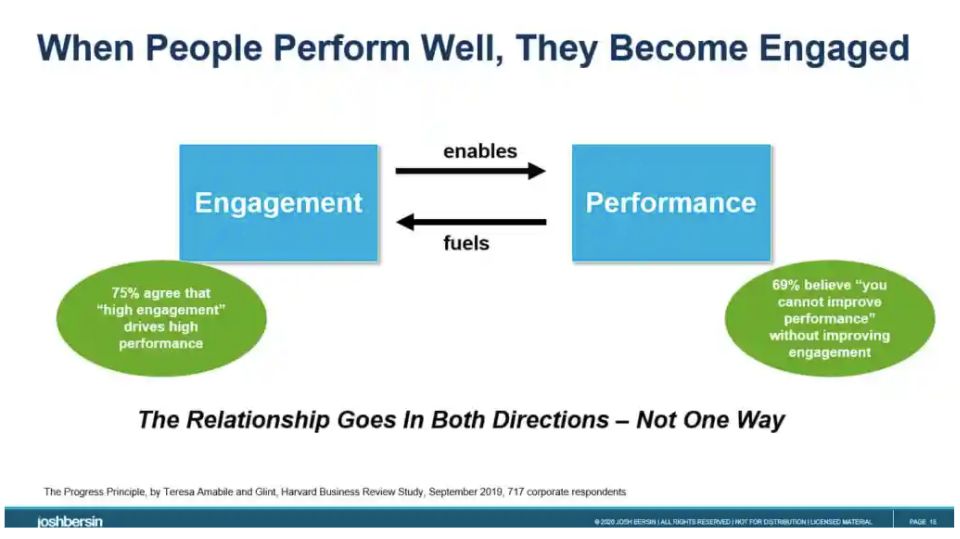Performance management or engagement first?

Great performance management is synonymous with great management. In the post-pandemic world, performance management and engagement have become increasingly intertwined. The rise of remote working and the hybrid workforce poses a range of new challenges for managers and HR leaders seeking to get the most out of a disparate workforce.
Josh Bersin’s article, Performance Management in the Pandemic: Becoming Your Best-Self, outlines how performance management has become intimately linked to employee self-realization:
“[T]he focus is not on managing performance or setting goals. Rather it is on helping people grow, creating clarity about priorities and objectives, and helping people build relationships with others so everyone can get the help, respect, and freedom to succeed.”
The report goes on to highlight an example of the importance of engagement, in which employees share contributions and developmental goals. Chief People Officer of True Car explains how ongoing performance dialogue benefits their employees:
“We focus on how engaged our employees are. When people are engaged, they know what’s expected, they’re recognizing others and getting feedback, and projects are getting done.”
Here are our five tips to help drive the transformation of your performance management strategy in the world of hybrid working.

1. Make it useful
Performance management delivers the best outcomes when it has clear links to organizational goals. When there is no clarity and visibility of how individual performance feeds into wider business objectives, employees can lose faith in its meaning and feel as if they are engaged in something pointless.
This is why performance management should be framed correctly from the outset. It should be linked to the roles and responsibilities of the individual in a way that aligns to the organization’s values and vision. It should imbue employees with a sense of purpose in a way that generates a positive employee experience. And it should be a continuous process, focused on outcomes yet flexible to allow for constant adaptations to new demands and challenges.
When establishing a performance management protocol, ask yourself:
- What is the purpose of your performance management strategy?
- What goals do you want to achieve, both as a company and for individual employees?
- What are the core values of the organization?
- How can these values be effectively understood by the workforce?
- Does the company’s mission statement clearly articulate these values?
- Are employees able to offer valuable input into the way the organization’s vision is achieved?
Through answering these questions, business leaders and managers can ensure that performance management is focused on achieving positive outcomes.
2. Provide continuous feedback
Prior to the pandemic, there was an assertive shift in the business world away from annual appraisals. Business and HR leaders increasingly understood this process was clunky and unreliable. Consequently, companies began to shift towards a model of continuous feedback with regular reviews focused on real-time feedback.
Making annual appraisals more effective and efficient with continuous feedback

The contrast between annual appraisals and continuous feedback is stark. Yet many businesses still lack the necessary tools to implement continuous feedback processes to complement their annual appraisals. However, the benefits of doing so can be impressive, saving countless hours of preparation and making sure all discussions are relevant and constructive.
Let’s briefly examine some of the pitfalls of annual appraisals when they are conducted without continuous feedback mechanisms:
- Time-consuming. HR professionals and managers are often overwhelmed in the run-up to annual performance appraisals, since there is a huge amount of data which requires reviewing. This makes annual appraisals among the most time-consuming aspects of their roles.
- Reactive. Since many of the projects and tasks performed by employees were finished weeks or even months before the appraisal, the best managers can do is react post-hoc. This means there’s little to no room for real-time corrective measures.
- Compromised by biases. Annual reviews come with a range of cognitive biases which renders them ineffective. An example is recency biases, which means that employees are often only truly assessed on performance in the run-up to the appraisal.
- Increase employee anxiety and tension. Holding appraisals annually means that employees feel as if a lot is riding on one yearly event. This contributes to higher levels of anxiety and tension, which itself can have an avoidable negative impact on performance.

By contrast, continuous feedback combined with regular reviews nullifies the negative aspects experienced when only performing annual appraisals.
Regular feedback and reviews are:
- Easy to plan and conduct. Regular reviews require less data to be gathered and analysed, making planning and conducting such reviews much easier. Since performance management tools deliver real-time data across a range of factors, managers can narrow down pertinent information in considerably less time compared to analysing a years’ worth of employee information.
- Proactive. The issues related to performance raised in monthly and quarterly reviews often relate to projects and employee goals which are still underway. This allows for a proactive stance on the review process. Rather than examining what went wrong (or right) after the fact, these reviews allow for corrective measures to take root and drive performance in the here and now.
- Relatively free from biases. While it isn’t possible to eliminate every bias imaginable (all managers are susceptible to personality clashes), many of the biases inherent in annual appraisals are no longer applicable once reviews are conducted regularly.
- Tied to relevant recognition and rewards programs. Regular reviews provide opportunities for regular – and timely – praise. Performance management tools are geared towards delivering recognition as and when it is appropriate, and can be tied to ongoing reviews.
3. Focus on the deliverables, not the ‘when’ and ‘where’
Traditional management by observation is no longer an option in an era of hybrid working. Observational management has always fallen short, whether this relates to the amount of time an employee spends at their desk, or the number of hours logged online.
Just as these measures are not an accurate predictor of productivity, they can also amplify biases. An on-site worker who is seen regularly might be perceived as more reliable and hard-working than a remote worker, simply because the remote worker isn’t visible to managers and their colleagues.
To counteract these pitfalls when addressing a hybrid workforce, managers should focus their attention on deliverables and deadlines when conducting employee evaluations. Once objectives and expectations have been clearly defined, managers can marshal the necessary data and metrics to make fair assessments.
This data analysis can then be complemented with regular one2one check-ins, whether this is in-person or virtual. This minimizes unconscious biases and allows managers to document progress and offer real-time guidance and support.
Use data to understand how well an employee is performing
With so much data available for businesses to analyse, it can be easy to get swamped with information. Performance management software allows business leaders and managers to run analytics and reports on data and sift through to what matters the most.
Deloitte’s analysis of the market landscape, People Analytics Solutions: Market Primer, outlines the importance of a multi-faceted approach to how data is collated and analysed:
“High-performing organizations are three times more likely to encourage experimentation with analytics tools and models and, as a result, report higher financial outcomes. These organizations bridge the productivity gap with PA solutions, putting insights into the hands of those who need them most—leaders, managers, and even individual workers, inside and outside of the HR department.”
Conduct regular one2one check-ins
This data can be used to support assessments and decision-making as part of regular one2one check-ins between managers and employees. Whether these are conducted in-person or virtually, one2one check-ins allow managers to offer real-time guidance and support, documenting these meetings with employees to create an evolving record of their progress.
These regular conversations help to reduce the typical unconscious biases found with infrequent reviews such as annual appraisals. The work being discussed is often relevant to ongoing projects, so managers and employees alike can take the opportunity to address issues in a proactive manner. This means action can be taken to correct any problems before it’s too late, rather than just analysing what went wrong well after the fact.
4. Find flexible and effective ways for measuring progress

Measuring an employee’s progress and performance isn’t easy when managers don’t get to see them face to face. Remote working sets up invisible barriers, requiring a more flexible approach to how performance management is undertaken.
One method which delivers this flexibility while also helping to bridge the digital divide between individuals and their colleagues is to introduce shared departmental objectives and key results (OKRs).
Implement shared objectives and key results (OKRs) across teams and departments
The majority of work conducted by an employee fits into the wider context of projects carried out by their team and department. Rather than a series of disconnected employees with individual goals, staff are nodes in a network connected to other people, projects, and information.
Performance management software developers understand this, which is why their tools allow users to share new and existing objectives with people within a given group. Progress towards deadlines, status updates and conversations relating to the project can all be synchronised across a shared group.
Automated notifications alert managers and members of the group to any changes. This not only ensures all parties are kept in the loop about changes, it also creates a sense of shared ownership and collective responsibility.
Development objectives can be dealt with in a similar fashion, for instance by giving each member of a team the same coursework or coaching towards a shared goal. Team members are encouraged to cooperate and help one another to achieve these development goals, in effect helping to coach one another.
Individual growth within an organization helps everyone to thrive, and personal development goals and objectives can be set which feed into the wider learning of the company. With performance management tools also delivering comprehensive organizational charts, HR leaders can more effectively direct learning resources to those who need them.
5. Adopt a coaching approach
Coaching and learning should be embedded throughout the performance management process. From the moment a new employee starts life in the company, personal development plans help to guide their learning experience in the context of their roles and responsibilities.
This coaching approach can be facilitated by:
- Offering multiple paths for career growth. Multinational corporations such as Disney and Walmart offer their employees a range of “career pathways” to facilitate growth. Education, assignments and training programs all help to give employees opportunities to develop their career goals.
- Adopting a multi-faceted approach to learning. Growth can be achieved in a variety of ways, from mentoring and coaching to AI-based learning systems. Offering the right approach to learning at the right time helps to develop employee talent stacks while increasing engagement and boosting performance.
- Creating a culture of learning. When employees feel as if their company is focused on their improvement, they are more likely to proactively take advantage of the courses and training options available to them.
FAQs
If you’re still unsure about the role of performance management in the post-pandemic world, these answers to frequently asked questions should help clarify some key points.
What is new in performance management?
One of the biggest shifts in how performance management is conducted is centred around engagement and well-being. Performance management is rapidly adapting to these new challenges by delivering the digital resources necessary to enhance the employee experience across a hybrid workforce.
How will performance management evolve in 2021?
As the role of hybrid working continues to evolve, performance management will continue to demonstrate the need for adaptability and flexibility. As such, managers and business leaders will shift towards an agile mindset in which the well-being and needs of the employee become a top priority.
Why is performance management important in 2021?
By allowing managers and team leaders to engage with the workforce on a regular basis, performance management in 2021 will become increasingly important. The tools provided through performance management software provide the connective tissue linking remote workers together.
Managers can identify and address issues as soon as they arise through efficient tracking of metrics combined with continuous feedback. At the same time, HR leaders can gain valuable insights into the organization’s structure to make the best decisions around hiring and promotions.





